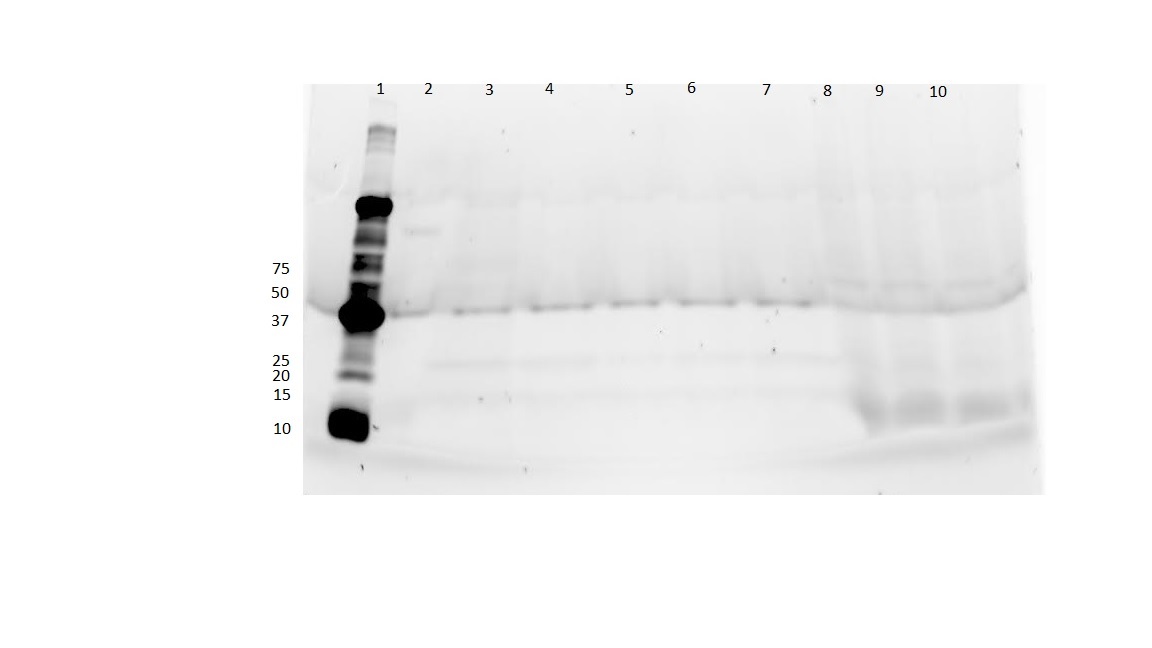Difference between revisions of "Team:UCLA/Notebook/Honeybee Silk/12 August 2015"
(→Results) |
(→Multiple Mini Expressions: Optimizing protein yield) |
||
| Line 287: | Line 287: | ||
<div id="contentContainer"> <!--The closing tag for contentContainer should be placed at the bottom of each content page.--> | <div id="contentContainer"> <!--The closing tag for contentContainer should be placed at the bottom of each content page.--> | ||
</html> | </html> | ||
| + | ='''Transformation with the Silk+GFP Construct'''= | ||
| + | |||
| + | |||
| + | #Thaw cells (~80uL) on ice for 10 minutes. | ||
| + | #Add 1uL of ligated product. | ||
| + | #Place on ice for 5 minutes. | ||
| + | #Rescue in 320uL of SOC, incubate and shake for 1 hour. | ||
| + | #Warm chloramphenicol plates at 37C. | ||
| + | #Spin down bacteria to pellet, discard supernatant. | ||
| + | #Make 2 serial dilutions (1:10 and 1:100) | ||
| + | #Plate 100uL of bacteria (1:1, 1:10, 1:100) on each plate. | ||
| + | #Spread with beads, incubate at 37C. | ||
| + | |||
=Multiple Mini Expressions: Optimizing protein yield= | =Multiple Mini Expressions: Optimizing protein yield= | ||
*Today we are testing multiple growth conditions of our bl21 cells for total cell and protein yield. Parameters we are optimizing are iptg concentration, and growth temperature. | *Today we are testing multiple growth conditions of our bl21 cells for total cell and protein yield. Parameters we are optimizing are iptg concentration, and growth temperature. | ||
Latest revision as of 21:57, 24 August 2015
Transformation with the Silk+GFP Construct
- Thaw cells (~80uL) on ice for 10 minutes.
- Add 1uL of ligated product.
- Place on ice for 5 minutes.
- Rescue in 320uL of SOC, incubate and shake for 1 hour.
- Warm chloramphenicol plates at 37C.
- Spin down bacteria to pellet, discard supernatant.
- Make 2 serial dilutions (1:10 and 1:100)
- Plate 100uL of bacteria (1:1, 1:10, 1:100) on each plate.
- Spread with beads, incubate at 37C.
Multiple Mini Expressions: Optimizing protein yield
- Today we are testing multiple growth conditions of our bl21 cells for total cell and protein yield. Parameters we are optimizing are iptg concentration, and growth temperature.
| IPTG concentration/Temp | 37C | 30C |
|---|---|---|
| 0.1 mM | ||
| 0.5 mM | ||
| 1.0 mM | ||
| 2.0 mM |
- We will test these different conditions using the following protocol
- Grow up a starter culture using glycerol stock #1 of our silk in BL21 to an OD of around 1. (4 to 5 hours)
- Add 50 ul of starter culture to 5 ml of LB starting around 5 pm along with 5 ul of Kan.
- Add in the varying amounts of IPTG and use the two different temperatures.
- Use the following protocol to analyze the cell pellet.
- Record the weight of the pellets.
- In total, the pellet weighed 1.75 grams, or about 0.6 grams per 100ml, which is lower than the 0.8 grams we have gotten in the past.
- Transfer pellet to one falcon tube.
- Resuspend in 5 ml/g (8.75ml) of pellet Bug Buster (1x) by pipetting and gently vortexing.
- Put on shaker or rotating mixer for 15 min at RT.
- Take first fraction, (F1) of this full cell lysate.
- Centrifuge 16000 g 20 min at 4 degrees C
- Take second fraction of this supernatant (S1) which should contain soluble proteins, while our desired protein should be in the pellet.
- Resuspend in the same volume of 1X Bugbuster 8.75ml as above.
- Make sure the pellet is completely resuspended!
- Take Fraction at this point (F2) Cell lysate #2
- Add DNAse (1 ul) and let rotate 20 min. (This may have been too much DNAse but it should be ok.)
- Add dry lysozyme to concentration of 200 ug / ml
- Dissolved the lysozyme in water and added the water.
- Let incubate on ice 30 minutes, swirl every 5 min.
- Take another fraction (F3) here, to see if there is a difference after adding the DNAse and the lysozyme.
- Add 6 volumes of 1:10 diluted bugbuster (.1X)
- Can split up into two falcon tubes if necessary.
- Vortex for 1 minute
- Centrifuge 16000g 15 min. 4 degrees C to collect inclusion bodies.
- Collect supernatant as fraction (S2). Inclusion body should be the pellet.
- Resuspend inclusion body pellet in 3% SDS solution and incubate at 60 C in the water bath for 2 hours.
- Used 10 ml of SDS. (Final)
- Store at 4C for further processing and analysis.
Results
- The results of this experiment was intended to guide which growth conditions we use in order to express honeybee silk and conduct further experiments.
- The results we are using to determine the optimal conditions are the weights of the cell pellets, the results of the BCA assay and the SDS PAGE.
| IPTG concentration | Weight of bacterial pelleet (grams 37C) | Weight of bacterial pelleet (grams 30C) |
|---|---|---|
| 0 | 0.029 | 0.034 |
| 0.1 mM | 0.050 | 0.024 |
| 0.5mM | 0.026 | 0.038 |
| 1.0 mM | 0.027 | 0.036 |
| 2.0 mM | 0.024 | 0.038 |
- Keep in mind that these weights are not super accurate because they are the wet weights, and we just tried to get as much water out as possible.
- SDS PAGE gel
- The BCA assay also did not indicate much of a difference between different IPTG concentrations.
- Therefore I think I will just continue with 37 C and 0.5mM iptg for the time being.
